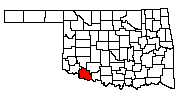by Carolyn Maxwell
The first known people to inhabit what is now Tillman County were the Plains Indians, primarily Kiowas and Comanches. This land was only a small part of a great expanse of hunting grounds that they roamed. Leading a nomadic life, the Indians moved with the seasons, dependent on the vast buffalo herds which provided them with food, shelter, clothing.
Their relatively peaceful existence was irreparably interrupted by the advent of the white man. The first to come in numbers were the adventurers, oftentimes only passing through on their way to the gold fields in California. They were followed by a trickle of settlers, which soon after became a mainstream of pioneers going west. U.S. Army soldiers were sent to protect the white settlers from the Indians who were determined to hold their lands inviolate. (Camp Auger was established on Red River, in what would become Tillman County, as an outpost from Fort Sill. Its purpose was to keep an eye on the roving Kiowas and Comanches.)
Bloody battles were the result of the meeting between Indian and Army. The Indians won victories, but more often, they suffered defeats and were gradually brought to submission. Coerced into "peace" treaties, the Kiowas, Comanches, and Plains Apaches were assigned to a reservation of 4639 square miles, an area the size of Connecticut. All of Tillman County, as we know it, was included in the reservation.
Meanwhile, great cattle empires were being established in north Texas, and, before long, the cattle barons were enviously eyeing the fertile pasture land allotted to the Indians north of the Red River. These influential men, primarily W.T. Waggoner and Burk Burnett, began making contacts and soon negotiations to lease the Indian lands were made.
Most, if not all, of Tillman County was leased by Waggoner and Burnett, so during the next several years the history of this area was the story of big cattle operations; cowboys, round-ups, brandings, trail-drives.
As the pioneers continued their trek west, pushing the boundaries of civilization before them, other white men began to eye this land, too, but with another idea in mind. The homesteader wanted to settle on it and raise crops. Congressmen were petitioned to favor the settlers' cause, and in 1892 a commission negotiated an agreement. In lieu of communal holding of the entire reservation, the Indians accepted individual allotments of land. Surplus acres remaining after each Indian received his share were to be given away for settlement under the homestead laws. The cattle men opposed the homesteaders, knowing they would lose their pasture leases, and they managed to forestall the settling until 1901.
But on August 6, 1901, at Lawton a land lottery was held. About 200,000 people registered, either at Fort Sill or El Reno, in person or by proxy, the number being more than fifteen times as many as there were available places. The land to be drawn for included what is now Caddo, Comanche, Cotton, Kiowa, and Tillman Counties. Roughly, there were 13,000 tracts of 160 acres each available. There was more land than this, but what was supposed to be the most choice lands had been reserved for the Indians. The largest of these, about 440,000 acres, was the Big Pasture. There were three other smaller areas also set aside for the Indians.
Among the 13,000 who drew the lucky numbers were people of all professions, both men and women. A Mr. Woods drew #1 and a Miss Beale drew #2. Both chose sites as close as possible to Lawton, then a city of tents.
Our section of the land included in the lottery, the extreme southwest part, was among the last chosen by the number holders. In fact, many places in this area were not filed on before the end of the 60-day period allowed. These were grabbed up, however, when opportunity permitted others to file.
A person who filed on a tract had six months, in which to settle and make improvements. This was called "proving up." Failure to do so allowed others to contest the claim at the end of the grace period.
Shortly after the 1901 land opening, six government townsites were designated in our area: Thacker, Jarrell, Gosnell, Manitou, Hazel, and Olds or Texowa (which became Davidson.) Except for Jarrell, northeast of Frederick, and Thacker, two miles west of Manitou, the townsites were to be located on the Blackwell, Enid, and Southwestern Railroad (BES, later the Frisco) which was rapidly laying tracks north from Texas.
Davidson is considered by many to be the oldest town in Tillman County because the BES arrived there first. The town's name was changed from Olds by Charles E. Hunter, townsite agent for BES, Davidson being the name of the railroad official.
Hunter was convinced to put the railroad through Gosnell instead of nearby Hazel by citizens voting to re-name Gosnell after Frederick VanBlarcom, the son of the BES official. Fledgling Hazel then moved to Frederick.
Hunter decided that instead of putting a railroad depot at Manitou, he would place it at Siboney, two miles north of Manitou. An intense rivalry resulted that finally ended in 1906 when Siboney, the depot included, was moved, 42 buildings in all, to Manitou.
The Big Pasture and three other smaller pastures opened for settlement in 1906. This opening was a radical departure from previous ones in that it was done by sealed bids. Bids were submitted to and opened by officials in Lawton. With the addition of Big Pasture lands, what would become Tillman County almost doubled in size.
The opening of the Big Pasture brought three more government townsites to the area, Eschiti, Isadore, and Quanah. Eschiti and Kell, an "illegal" town since it wasn't government designated, united to become Grandfield; Isadore and Quanah withered.
With the coming of the Katy Railroad, Loveland, Hollister, and Tipton sprouted on the prairie.
About the only objections that the settlers in this rich new land had were that Oklahoma was still a territory, and it was at least a two-day trip to Lawton, the county seat, since this was a part of Comanche County then. These situations were remedied by 1907 statehood and the creation of Tillman County, with Frederick as the county seat.
Seven bustling towns were thriving in the new county: Davidson, Frederick, and Manitou on the Frisco line, Grandfield, Loveland, Hollister, and Tipton on the Katy. Tillman County entered the twentieth century with great expectations!
(First published in The Frederick Press, April 4, 1975)



